Microcement kitchens: benefits and most popular styles
The microcement kitchens are the preferred option of more and more renovation professionals, architects and decorators due to the multiple advantages offered by this decorative coating. A coating that guarantees unique creations to renovate a room as important as the kitchen.
One of the peculiarities of microcement in kitchens is that it can be implemented in many ways thanks to its versatility. In this way, we find kitchens with microcement on floors, walls, countertops and even sinks. A wide range of fields of use to which must be added the great variety of colours available for this material. Two factors that, together, allow for free rein of creativity. Any kitchen design is possible.
Its absence of joints, which enhances the continuity and brightness of the room; gives a plus to a groundbreaking aesthetic and, above all, to a very functional kitchen. Whatever the surface coated with microcement, it ensures a good resistance to wear by abrasion, traffic and ambient humidity, among other virtues.
The finishes of kitchens with microcement are plural, adjusting to the tastes and preferences of each individual. A coating that stands out for the ease it offers to complement the rest of the room's elements at a decorative level. Smooth finishes, finishes with greater shine, finishes with more marked textures, water effects, etc. Below, we detail the main benefits of a rising decorative trend.
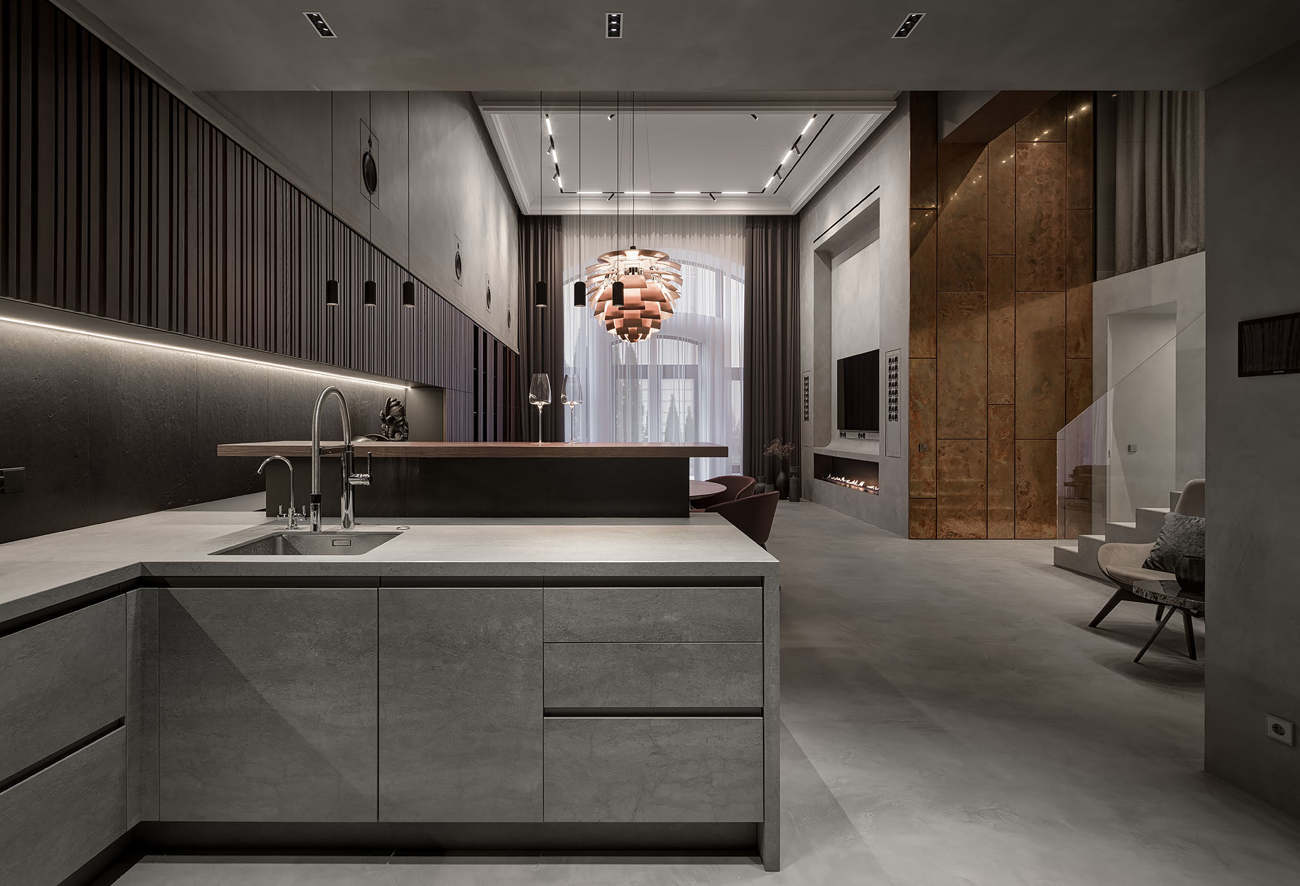
Advantages of microcement in kitchens
Microcement in the kitchen offers numerous advantages, regardless of the surface on which this coating is chosen to be used. Especially because it allows a quick renovation of the kitchen without it becoming uninhabitable, as there is no need to carry out works and, consequently, rubble and dirt generation are avoided.
Next, we explain the main qualities so you understand why microcement kitchens have become an absolute trend in kitchen renovations of homes, restaurants and hotels.
1. Applying microcement in the kitchen does not require construction work
When it comes to renovating a room, time is gold. Even more so when it comes to a kitchen. As this decorative coating is compatible with virtually any material, the microcement in the kitchen is applied directly onto the existing surface without the need for construction work. In just a few days, your new kitchen will be ready.
2. Diversity of colours in kitchens with microcement
There is a wide variety of microcement colours to coat your kitchen with. From more neutral shades such as white, grey or black to more striking pigments. At Topciment, we have a complete colour palette to create an environment full of inspiration.
3. Microcement kitchens have good thermal resistance and to chemicals
This coating enjoys good thermal resistance and also to household cleaning products. Two differential factors that have made microcement floors and walls fashionable in kitchens as well as kitchen countertops coated with microcement.
4. Kitchens with microcement can be waterproof
Beyond the decorative value, for rooms such as kitchens what is sought above all is a coating that is very functional and adapts to needs. In this sense, ensuring a waterproof finish in a space so exposed to water and similar liquids, is fundamental. Hence the popularity of microcement in kitchens. And it is that with the use of varnishes and sealers designed by Topciment, kitchens with microcement can be waterproof. But not only is the support completely waterproofed, but it also provides an extra hardness. A 2 for 1 in every rule!
5. The microcement in kitchens can be non-slip
In the same way that impermeability is an added value of microcement in kitchens, its ability to also be non-slip is another of its great advantages over other coatings. But, in this case, it is also necessary to use the right product. At Topciment we have developed Topsealer WT Anti Slip , a water-based polyurethane varnish thanks to which any surface becomes non-slip. An ideal finish especially for flooring.
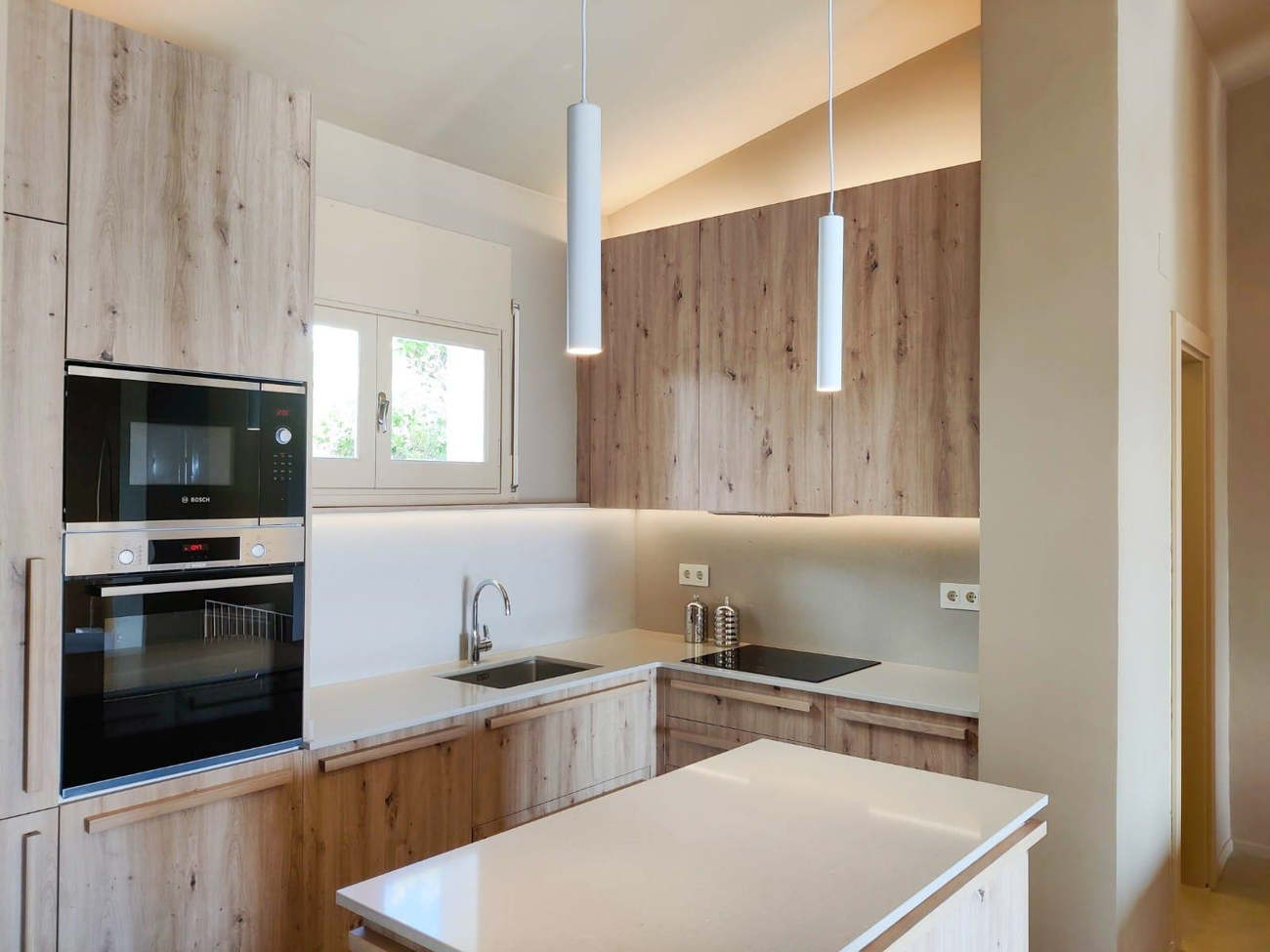
Microcement kitchens for all styles
If there is something that characterises this material, it is the wide range of possibilities it offers. For each decorative style, there is a perfect microcement kitchen. At Topciment we propose five different styles of microcement kitchens:
Minimalist microcement kitchens:
For those who opt for a kitchen where straight lines predominate both in the furniture and in the layout of the space. The absence of joints promotes the continuity of microcement kitchens, a fundamental factor in minimalist design.
Eclectic microcement kitchens:
For people who, on the other hand, prefer a kitchen that combines different types of materials such as plasterboard, slate or tiles. In eclectic microcement kitchens, you can combine the traditional with the modern, luxury with simplicity. A 100% winning combination.
Nordic microcement kitchens:
You don't need your kitchen to be huge for it to shine with its own light. The Scandinavian or Nordic style is ideal for small microcement kitchens, as it enhances the beauty of the smallest details. The white tones will not only magnify the dimensions of your kitchen, but will also enhance the natural light of the room.
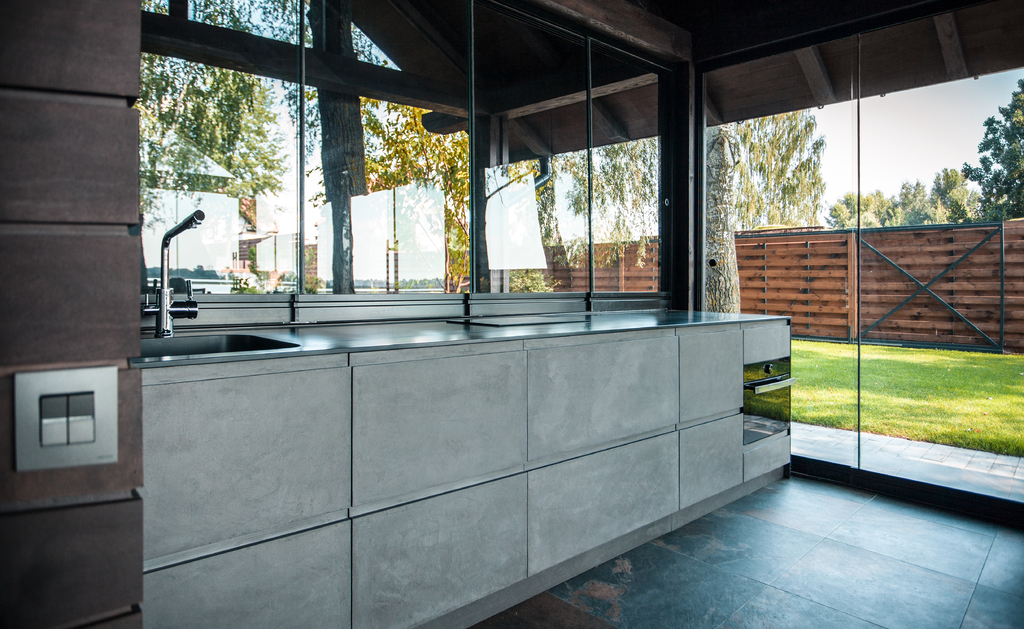
Industrial microcement kitchens:
Do you prefer a kitchen with a more modern, avant-garde and urban aesthetic? We propose a 100% industrial style, increasingly widespread in interior decoration such as kitchens. In industrial microcement kitchens, the combination of walls and floors of this continuous coating in grey and black colours predominates. An industrial atmosphere that you will easily achieve with the use of Industtrial, our epoxy microcement. A coating that offers greater resistance to traffic and waterproofing.
Rustic microcement kitchens:
Kitchens with a distinct rustic style have a special character. They convey warmth and tranquillity like few others, two everyday sensations that we all seek in our day-to-day life. An atmosphere that can be achieved, even though it may seem an impossible mission at first, in a space with as much hustle and bustle as a kitchen implies.
It's what is called "home warmth" and embraces the use of handmade materials, custom pieces and antique objects. As well as the use of decorative coverings such as stone and wood, absolute protagonists of this trend completely opposite to minimalism.
The preconceived idea that rustic kitchens only have a place in country or mountain houses is far behind. In fact, it is increasingly common to opt for this decorative style in large cities as it is a style that never goes out of fashion and that, with the use of microcement, can be accentuated even more if possible. Do you have wooden beams on the ceiling? Apply earth-coloured microcement on the floor or white microcement on the countertop and enjoy a winning combination.
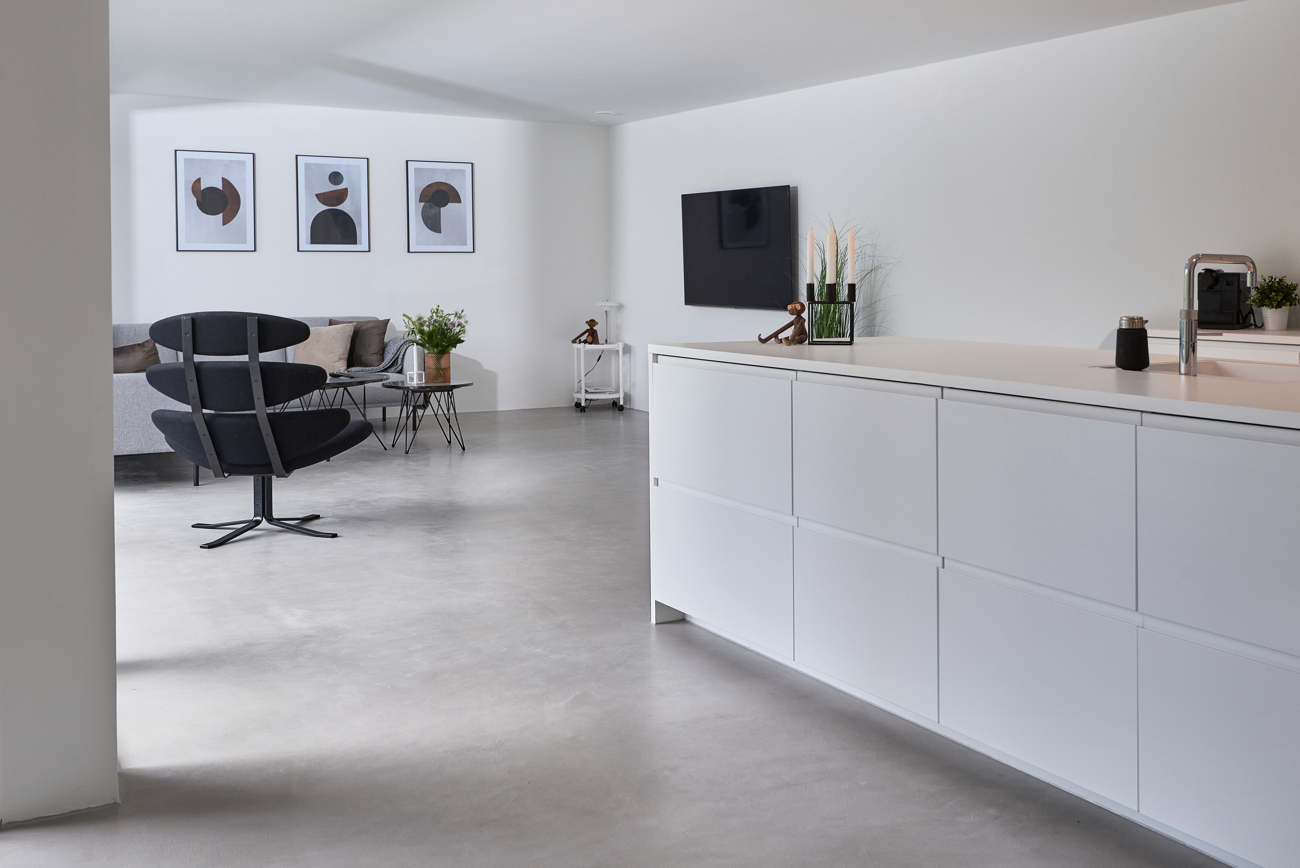
Kitchen with microcement and wood: the perfect duo
Following on from what was previously mentioned about rustic kitchens, if there is a proposal that captivates, it is to integrate microcement in the kitchen if there is wood involved. Two coatings that associate wonderfully with each other and that can make a difference in the room.
And contrary to what one might think, microcement is a very warm decorative coating if it is intelligently incorporated and combined with the appropriate coverings. Such is the case with wood, one of the most suitable materials to complete microcement kitchens. The result is a warm, spacious and very pleasant room where soft finishes and enveloping shapes will be enhanced.
Microcement on the kitchen wall
Coating the kitchen wall with microcement allows for a great aesthetic change without investing a lot of money and time. A high-value decorative finish that brings distinction to the room for its enormous resources and textures. The finishes are almost endless.
A material that guarantees resistance to unwanted impacts from everyday objects as well as against environmental humidity. This last factor is very important, as it constitutes a room constantly exposed to contact with running water.
An added value of microcement on the kitchen wall that not all coatings provide and that, is largely a consequence, of its widespread use in this space. A peace of mind and security that it also ensures in terms of spilling all kinds of liquids and splashes. Two qualities to highlight, as when cooking it is inevitable that food scraps end up on the wall. Likewise, it is a material that provides the wall with excellent resistance to stains and scratches. In addition, it can be cleaned quickly and easily with water and neutral soap to always be in perfect condition.
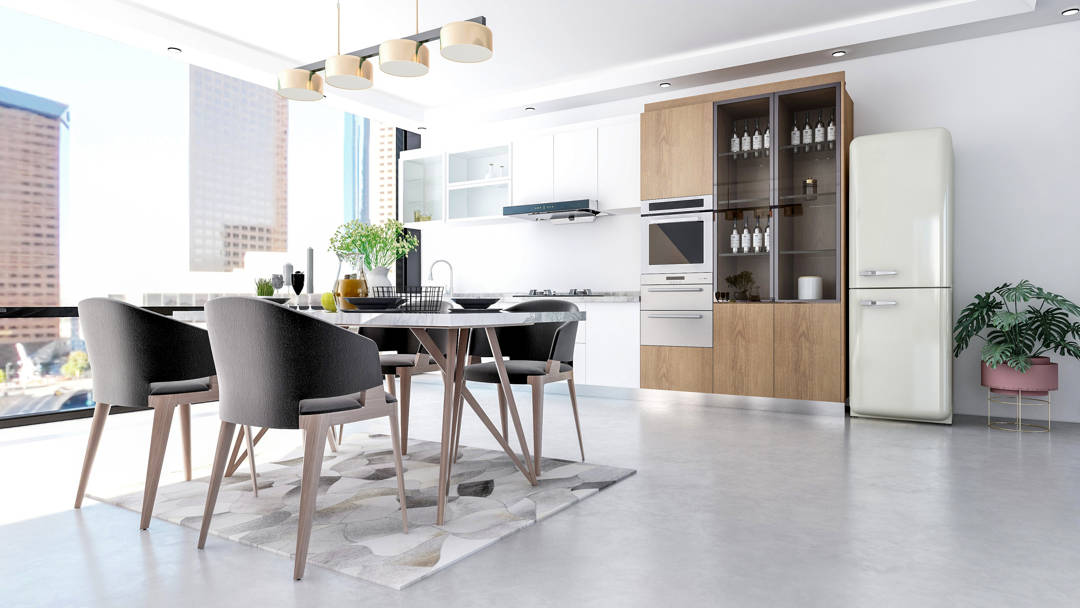
Microfine, the most suitable microcement for the kitchen wall
We developed Microfino with the idea of coating vertical and non-walkable surfaces, including the kitchen wall. A microcement that is characterised by having very good resistances, both chemical and mechanical. In fact, that's why more and more customers are daring to use it even on floors. A coating with a very natural look that we manufacture in three granulometries: XS, S and M. As for its composition, it is available both as a two-component microcement and a one-component microcement.
How to apply microcement on the kitchen wall
The method of applying microcement to the kitchen wall varies depending on the coating you want to use. The most used for its properties and finish is Microfino, whose application we are going to develop now. Although we also recommend taking into account Industtrial, our new addition. A harder and waterproof epoxy microcement. If on the other hand you prefer to opt for a ready-to-use microcement, there is also the option to apply Efectto Quartz.
1. Apply fibreglass mesh (only if Microfine is used).
2. Prime the kitchen wall with the most suitable promoter.
3. Apply two coats of Microbase or two coats of Industtrial XL/Industtrial Base.
4. Apply two coats of Microfino or one coat of Industtrial Medium/Industtrial Smooth.
5. Apply two coats of Presealer (only if Microfino is used)
6. Apply two coats of any varnish from the Topsealer range.
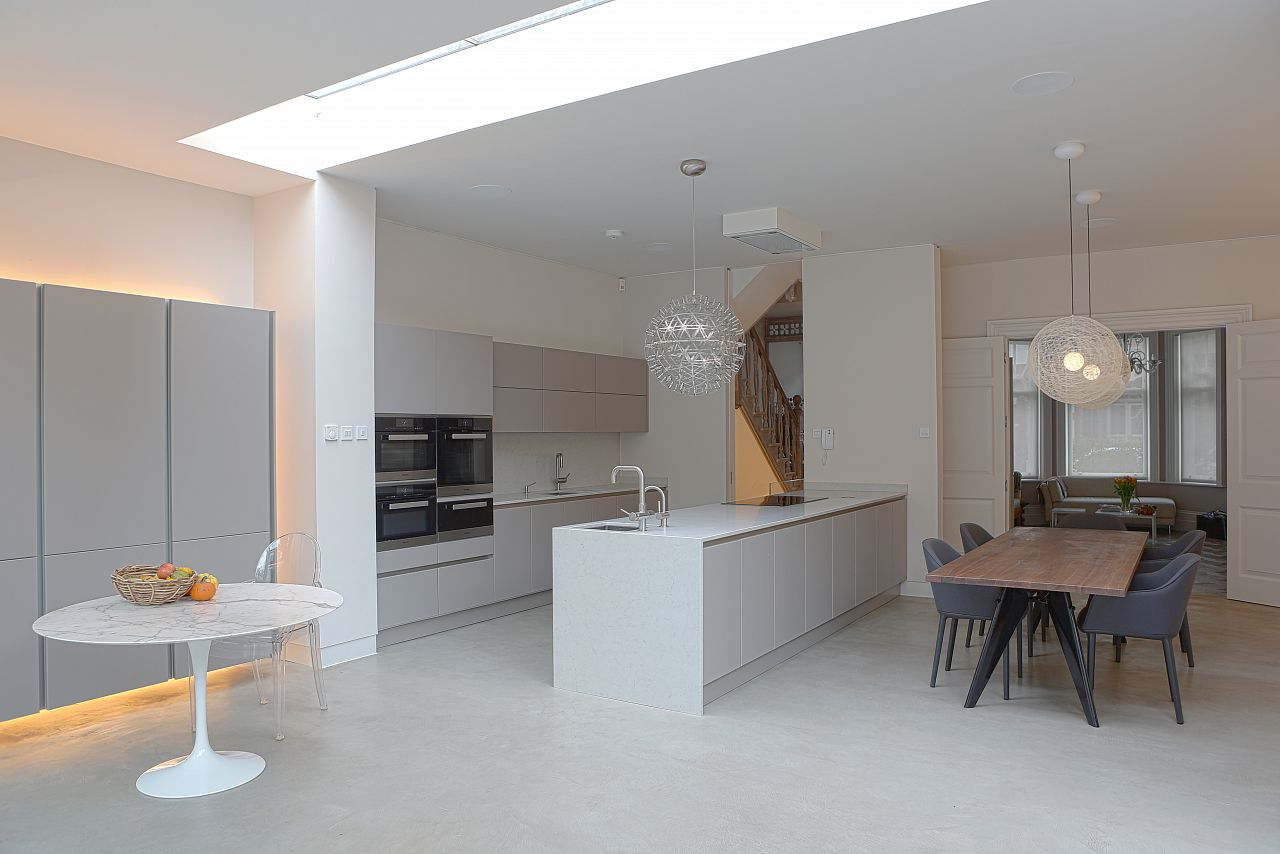
Microcement on the kitchen floor
The peculiarities of microcement on the kitchen floor are not left behind. Similarly, and depending on the composition of the material used as well as its granulometry, all kinds of finishes can be obtained. From floors with a finer, delicate and smooth appearance; to floors whose roughness is higher because a superior resistance to traffic is sought.
Putting aside the aesthetic component, which is still decisive in choosing microcement for the kitchen floor, it is necessary to point out its significant benefits. Starting with the fact that it is a very durable pavement, which does not crack and requires virtually no maintenance to remain the same as the first day.
The microcement floor in the kitchen is one of the smartest options to renovate the pavement due to the high resistance it offers to the wear of time, to abrasion, to the impact of blows and to traffic. In addition, as it is applied in a minimal layer of between 2 and 3 mm, it does not excessively raise the level of the original floor and therefore there is no need to level the new support.
Microdeck and Industtrial, the toughest microcements for the kitchen floor
Microdeck forms one of the most requested coverings in kitchen floor renovations. This finishing microcement provides magnificent resistance to traffic, impacts and wear by abrasion. In addition, it offers a non-slip finish without added treatments and can be applied with the "fresh on fresh" technique, thus expanding its already extensive decorative possibilities. M and L are its two granulometries, and in terms of composition, it is a product available as monocomponent and bicomponent microcement.
We have a more industrial and more waterproof cutting alternative than Microdeck: Industtrial. A microcement with epoxy resin that is much harder and that better withstands high traffic and wear by abrasion. Unlike other products on the market, the application layers are reduced, with only two coats of preparation microcement and a single finishing one being necessary. It is available in 4 granulometries and 16 colours.
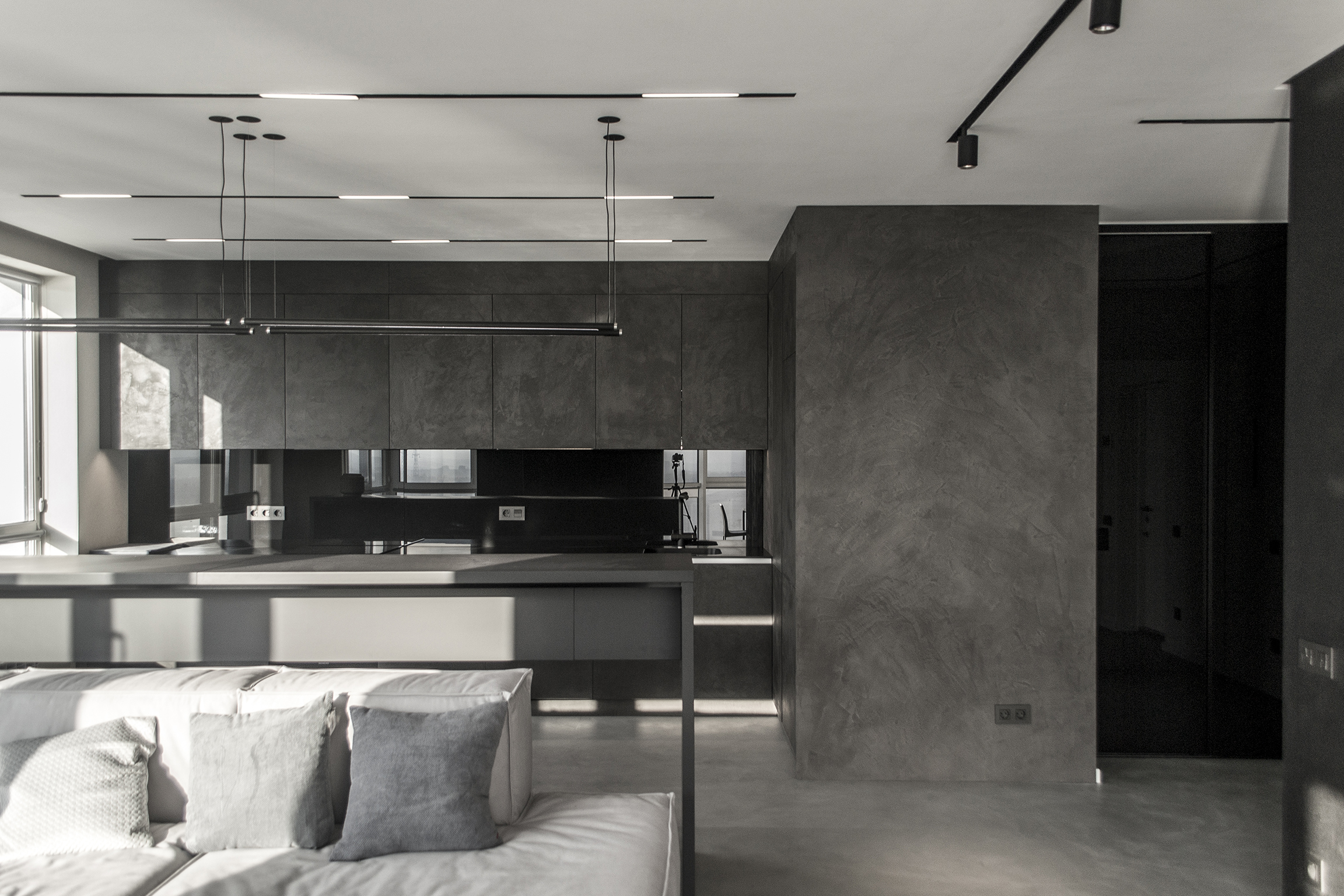
How to apply microcement on the kitchen floor
As for the method of applying microcement on the kitchen floor, it also varies depending on the chosen coating. We, as manufacturers, recommend using Microdeck or Industtrial. However, you can also use the ready-to-use microcement Efectto Quartz if you prefer (although we are not going to detail its application below).
1. Apply fibreglass mesh (only if Microdeck is used).
2. Prime the kitchen wall with the most suitable promoter.
3. Apply two coats of Microbase or two coats of Industtrial XL/Industtrial Base.
4. Apply two coats of Microdeck or one coat of Industtrial Medium/Industtrial Smooth.
5. Apply two coats of Presealer (only if Microdeck is used).
6. Apply two coats of any varnish from the Topsealer range.
Microcement on kitchen countertop
Kitchen countertops with microcement are becoming increasingly popular in part due to the abrasion and heat resistance that this decorative coating confers. In addition, its cleaning is very simple and can be quickly adapted to any shape the countertop has.
A benchtop that is much more than the space in which to manoeuvre within the kitchen and prepare delicious recipes. By only renovating the countertop, the appearance of the kitchen will be completely modernised and transformed without being invasive. Since it does not need to be replaced, but only covered with microcement. The result will be a fine and elegant finish, with a thickness that is practically imperceptible and will not affect the structural load of the furniture.
There are many colours of microcement for the countertop to choose from. While with white, for example, the room is nourished with harmony, cleanliness and minimalism; grey is more suitable for a more industrial and authentic environment. Whatever the microcement countertop you have in mind, the application process is the same.
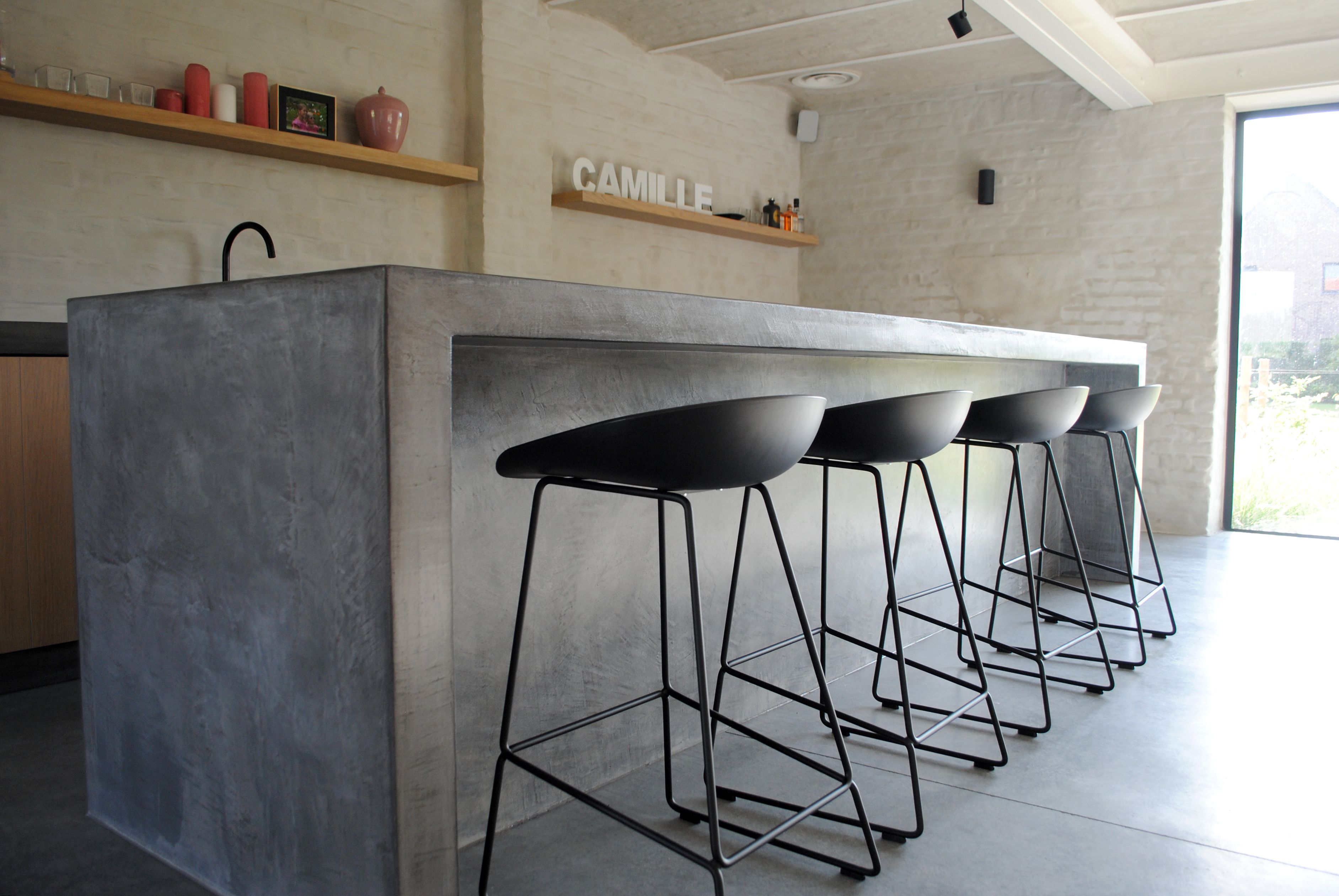
Tips to avoid problems in microcement kitchens
A number of factors need to be considered to avoid future microcement problems such as cracks, scratches or stains. From Topciment we give you four tips to avoid problems in microcement kitchens.
1. Trust a professional to apply the microcement in the kitchen:
Only an expert can guarantee the success of the application of microcement in kitchens and prevent the material from cracking. At Topciment, we continuously train professionals in the application of our continuous coatings.
2. Bet on quality microcement for the kitchen:
Not all types of microcement have the same quality and this affects the appearance of possible problems in kitchens with microcement. The decorative coatings from Topciment guarantee unbeatable technical performances.
3. Protect the microcement in the kitchen:
Although this coating is resistant, misuse can cause cracks, scratches or stains to appear over time. At Topciment we have created a line of specific varnishes and sealers with which you can protect the microcement in kitchens. Get to know the Topsealer range.
4. Use specialised cleaners for microcement kitchens:
The cleaning of a microcement kitchen can be carried out with water and neutral soap. However, to better preserve and for a longer time the microcement, it is advisable to use a specialised cleaner. For this purpose, we have manufactured the Ecoclean Basic range.
If you need more information about our products, resolve doubts about the application of microcement in kitchens or what type of microcement is most suitable,contact directly with our specialized technical service.
Subscribe to our newsletter
Receive in your email tips for the application and care of microcement, the latest trends and news from Topciment products.




